南京大学:《软件安全 Software Security》课程教学资源(PPT课件讲稿)Program Analysis - Data Flow Analysis
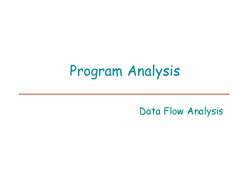
Program Analysis Data Flow Analysis
Program Analysis Data Flow Analysis
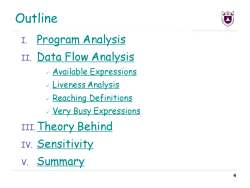
Outline 工. Program Analysis II.Data Flow Analysis Available Expressions Liveness Analysis Reaching Definitions Very Busy Expressions rrr.Theory Behind IV.Sensitivity v.Summary A
4 Outline I. Program Analysis II. Data Flow Analysis ✓ Available Expressions ✓ Liveness Analysis ✓ Reaching Definitions ✓ Very Busy Expressions III.Theory Behind IV. Sensitivity V. Summary
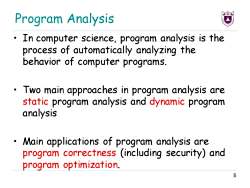
Program Analysis In computer science,program analysis is the process of automatically analyzing the behavior of computer programs. Two main approaches in program analysis are static program analysis and dynamic program analysis Main applications of program analysis are program correctness (including security)and program optimization. 5
Program Analysis • In computer science, program analysis is the process of automatically analyzing the behavior of computer programs. • Two main approaches in program analysis are static program analysis and dynamic program analysis • Main applications of program analysis are program correctness (including security) and program optimization. 5
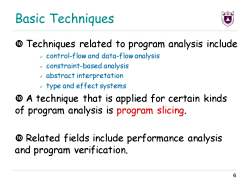
Basic Technigues D Techniques related to program analysis include control-flow and data-flow analysis constraint-based analysis abstract interpretation type and effect systems D A technique that is applied for certain kinds of program analysis is program slicing. Related fields include performance analysis and program verification. 6
Basic Techniques Techniques related to program analysis include ✓ control-flow and data-flow analysis ✓ constraint-based analysis ✓ abstract interpretation ✓ type and effect systems A technique that is applied for certain kinds of program analysis is program slicing. Related fields include performance analysis and program verification. 6
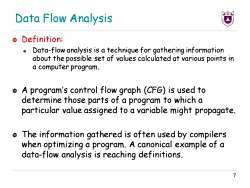
Data Flow Analysis Definition: Data-flow analysis is a technique for gathering information about the possible set of values calculated at various points in a computer program. A program's control flow graph(CFG)is used to determine those parts of a program to which a particular value assigned to a variable might propagate. The information gathered is often used by compilers when optimizing a program.A canonical example of a data-flow analysis is reaching definitions
Data Flow Analysis Definition: Data-flow analysis is a technique for gathering information about the possible set of values calculated at various points in a computer program. A program’s control flow graph (CFG) is used to determine those parts of a program to which a particular value assigned to a variable might propagate. The information gathered is often used by compilers when optimizing a program. A canonical example of a data-flow analysis is reaching definitions. 7
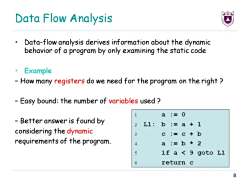
Data Flow Analysis Data-flow analysis derives information about the dynamic behavior of a program by only examining the static code Example How many registers do we need for the program on the right Easy bound:the number of variables used a:=0 Better answer is found by 2 L1:b:= :a+1 considering the dynamic 3 :=C+b requirements of the program. 4 a:=b*2 5 if a <9 goto Ll return c 8
Data Flow Analysis • Data-flow analysis derives information about the dynamic behavior of a program by only examining the static code • Example – How many registers do we need for the program on the right ? – Easy bound: the number of variables used ? – Better answer is found by considering the dynamic requirements of the program. 8
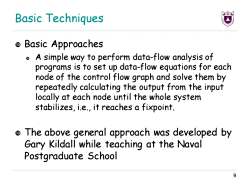
Basic Techniques Basic Approaches A simple way to perform data-flow analysis of programs is to set up data-flow equations for each node of the control flow graph and solve them by repeatedly calculating the output from the input locally at each node until the whole system stabilizes,i.e.,it reaches a fixpoint. The above general approach was developed by Gary Kildall while teaching at the Naval Postgraduate School 9
Basic Techniques Basic Approaches A simple way to perform data-flow analysis of programs is to set up data-flow equations for each node of the control flow graph and solve them by repeatedly calculating the output from the input locally at each node until the whole system stabilizes, i.e., it reaches a fixpoint. The above general approach was developed by Gary Kildall while teaching at the Naval Postgraduate School 9
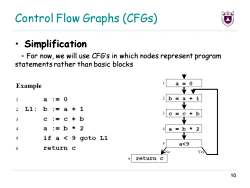
Control Flow Graphs (CFGs) ·Simplification For now,we will use CFG's in which nodes represent program statements rather than basic blocks Example a=0 1 a:=0 2b=a+1 2 L1:b:= a+1 Y 3 c= c+b 3 c :=c+b V 4 a:=b*2 4a=b*2 5 if a <9 goto Ll 7 5 a<9 6 return c No Yes 6 return c 10
Control Flow Graphs (CFGs) • Simplification – For now, we will use CFG’s in which nodes represent program statements rather than basic blocks 10
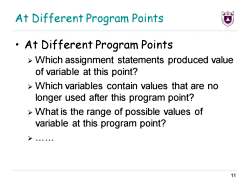
At Different Program Points At Different Program Points Which assignment statements produced value of variable at this point? Which variables contain values that are no longer used after this program point? What is the range of possible values of variable at this program point? 11
At Different Program Points • At Different Program Points ➢ Which assignment statements produced value of variable at this point? ➢ Which variables contain values that are no longer used after this program point? ➢ What is the range of possible values of variable at this program point? ➢ …… 11
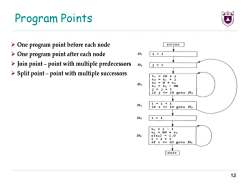
Program Points >One program point before each node ENTRY >One program point after each node B 1=1 >Join point-point with multiple predecessors B2 j=1 >Split point-point with multiple successors 七1=10*1 七2■ ti+j t3■8*七2 t4=t3 -88 j=j+1 if j<=10 goto Ba B4 1=1+1 1f1<=10got0B2 Bs 1=1 t5■1-1 =88*七5 a[t6]=1.0 1=i+1 if i <10 goto Be EXIT 12
Program Points 12
按次数下载不扣除下载券;
注册用户24小时内重复下载只扣除一次;
顺序:VIP每日次数-->可用次数-->下载券;
- 南京大学:《软件安全 Software Security》课程教学资源(PPT课件讲稿)Control Flow - Representation, Extraction and Applications.pptx
- 南京大学:《软件安全 Software Security》课程教学资源(PPT课件讲稿)Return-Orinted Programming(ROP Attack).ppt
- 南京大学:《软件安全 Software Security》课程教学资源(PPT课件讲稿)Format String Attacks.pptx
- 南京大学:《软件安全 Software Security》课程教学资源(PPT课件讲稿)Control Flow Integrity.pptx
- 南京大学:《软件安全 Software Security》课程教学资源(PPT课件讲稿)Redundant dynamic Canary.ppt
- 南京大学:《软件安全 Software Security》课程教学资源(PPT课件讲稿)Defense against Control Flow Hijack Defense - StackGuard, DEP, and ASLR.pdf
- 南京大学:《软件安全 Software Security》课程教学资源(PPT课件讲稿)Buffer Overflow Attack.pdf
- 南京大学:《软件安全 Software Security》课程教学资源(PPT课件讲稿)Software Security Overview.pptx
- 南京大学:《软件安全 Software Security》课程教学资源(PPT课件讲稿)Introduction to the course.pdf
- 海南大学:《网络安全技术》课程教学资源(课件讲稿)第9章 入侵检测系统.pdf
- 海南大学:《网络安全技术》课程教学资源(课件讲稿)第8章 抗恶意软件.pdf
- 海南大学:《网络安全技术》课程教学资源(课件讲稿)第7章 网络边防.pdf
- 海南大学:《网络安全技术》课程教学资源(课件讲稿)第6章 无线网安全性.pdf
- 海南大学:《网络安全技术》课程教学资源(课件讲稿)第5章 实用的网络安全协议.pdf
- 海南大学:《网络安全技术》课程教学资源(课件讲稿)第3章 公钥密码体系与密钥管理.pdf
- 海南大学:《网络安全技术》课程教学资源(课件讲稿)第4章 数据认证.pdf
- 海南大学:《网络安全技术》课程教学资源(课件讲稿)第2章 数据加密算法.pdf
- 海南大学:《网络安全技术》课程教学资源(课件讲稿)第1章 网络安全概论(齐琦).pdf
- 电子科技大学:《数字图像处理》课程教学资源(课件讲稿)第十章 图像分割.pdf
- 电子科技大学:《数字图像处理》课程教学资源(课件讲稿)第五章 图像复原(图像几何校正).pdf
- 南京大学:《软件安全 Software Security》课程教学资源(PPT课件讲稿)Taint Analysis.pptx
- 南京大学:《软件安全 Software Security》课程教学资源(PPT课件讲稿)Use-after-free.pptx
- 南京大学:《软件安全 Software Security》课程教学资源(PPT课件讲稿)Byzantine Generals Problem.ppt
- 南京大学:《形式语言与自动机 Formal Languages and Automata》课程教学资源(PPT课件讲稿)Finite Automata.pptx
- 南京大学:《形式语言与自动机 Formal Languages and Automata》课程教学资源(PPT课件讲稿)Context Free Grammar.pptx
- 南京大学:《形式语言与自动机 Formal Languages and Automata》课程教学资源(PPT课件讲稿)Regular Expression.pptx
- 南京大学:《形式语言与自动机 Formal Languages and Automata》课程教学资源(PPT课件讲稿)Pushdown Automata.pptx
- 南京大学:《形式语言与自动机 Formal Languages and Automata》课程教学资源(PPT课件讲稿)Properties of CFL(The Pumping Lemma for CFL’s).pptx
- 南京大学:《形式语言与自动机 Formal Languages and Automata》课程教学资源(PPT课件讲稿)Turing Machine.pptx
- 南京大学:《形式语言与自动机 Formal Languages and Automata》课程教学资源(PPT课件讲稿)Transition System.pptx
- 南京大学:《形式语言与自动机 Formal Languages and Automata》课程教学资源(PPT课件讲稿)Petri Net.pptx
- 南京大学:《形式语言与自动机 Formal Languages and Automata》课程教学资源(PPT课件讲稿)Timed Automata.ppt
- 南京大学:《形式语言与自动机 Formal Languages and Automata》课程教学资源(PPT课件讲稿)Decidability, Complexity(P, NP, NPC and related).pptx
- 《大数据 Big Data》课程教学资源(参考文献)Learning to Hash for Big Data Retrieval and Mining(南京大学:李武军).pdf
- 《大数据 Big Data》课程教学资源(参考文献)Learning to Hash for Big Data Retrieval and Mining(南京大学:李武军).pdf
- 《大数据 Big Data》课程教学资源(参考文献)大数据机器学习 Big Data Machine Learning.pdf
- 《大数据 Big Data》课程教学资源(参考文献)Learning to Hash for Big Data.pdf
- 《大数据 Big Data》课程教学资源(参考文献)Learning to Hash for Big Data.pdf
- 《大数据 Big Data》课程教学资源(参考文献)大数据机器学习 Big Data Machine Learning.pdf
- 《大数据 Big Data》课程教学资源(参考文献)Learning to Hash for Big Data - A Tutorial.pdf
